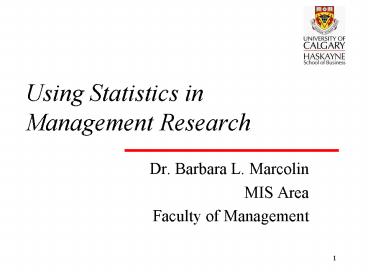Using Statistics in Management Research PowerPoint PPT Presentation
1 / 11
Title: Using Statistics in Management Research
1
Using Statistics in Management Research
- Dr. Barbara L. Marcolin
- MIS Area
- Faculty of Management
2
Welcome
- Email addresses
- Course outline
- Web site
- Labs
- Introductions
- Remainder of first day
- Introduction to key statistical terms
- Nature of quantitative data
- Running SPSS data files and syntax files
3
Multivariate Definition
- More than two variables (i.e., Multivariate)
- Assumed to have a multivariate normal data
distribution - All variables are extremely interrelated such
that it is difficult to separate them for
interpretation.
4
Measurement
- Scale
- Non-metric (qualitative)
- Nominal ( can assign to categories) or Ordinal
( can be ordered or ranked) - Metric (quantitative)
- Interval ( constant unit of measurement without
an arbitrary zero point) or Ratio ( constant
unit of measurement with an absolute zero point) - Error in measurement
- Reliability
- Degree to which the observed variable measures
the true value and is error free - Opposite of measurement error
- Validity
- degree to which a measure accurately represents
what it is supposed to measure
5
Significance
- When inferring from a sample to a population, the
researcher must specify an acceptable level of
error. - Alpha or Type I error is the chance of a false
positive OR falsely concluding that there is a
difference when there isnt one. - Beta or Type II error is the inability to reject
the null hypothesis (I.e., not being able to
detect a difference when you should). - Power (1-beta) is the probability of being able
to reject the null hypothesis. - Power is a function of effect size, alpha, sample
size and measurement error.
6
Key Terms
- Alpha (?) - Type I Error plt.05
- Beta (?) - Type II Error
- Power
- Practical significance
- Statistical significance
- Dependence technique
- Dependent variable
7
Key Terms (continued)
- Interdependence technique
- Independent variable
- Hypothesis Testing
- Dummy variable
- Effect size
- Indicator
- Non-metric data
- Metric data
8
Key Terms (continued)
- Multicollinearity
- Summated Scales
- Reliability
- Treatment
- Anova
- Multivariate analysis
9
Types of Univariate Techniques
- Parametric
- t
- variance test (?2)
- T-tests
- unparied (t-test groups )
- paried (t-tests pairs )
- F-tests
- Z test
- Non-Parametric
- Mann-whitney
- Sign test
- Wilcoxon Signed Rank
- Wilcoxon Rank Sum
- Kruskal-Wallis
10
Bivariate Techniques
- Pearson product-moment correlation x continuous,
y continuous. - Spearman r correlation (non-parametric)
- Kendalls tau correlation (non-parametric when
there are ties) - Chi-square Goodness of fit test
- Contingency tables and Fishers Exact test
- Point biserial correlation x dichotomous, y
continuous. - Phi coefficient x dichotomous, y dichotomous
11
Types of Multivariate Techniques
- Multiple Regression
- Analysis of Variance (ANOVA)
- SPSS oneway command
- ANCOVA
- Two-group discriminant analysis
- Logit (Multiple Frequency analysis)
- two group logistic regression
- Canonical Correlation
- Multiple Analysis of Variance (MANOVA) (SPSS GLM
command) - MANCOVA
- Profile Analysis
- Multiple Discriminant Analysis
- Factor Analysis
- Principal Components Analysis
- Structural Equation Modelling - LISREL, EQS,
AMOS, SEPATH, MX - Structural Equation Modelling - PLS
- Conjoint Analysis
- Multidimensional Scaling
- Cluster Analysis
- Correspondence Analysis

